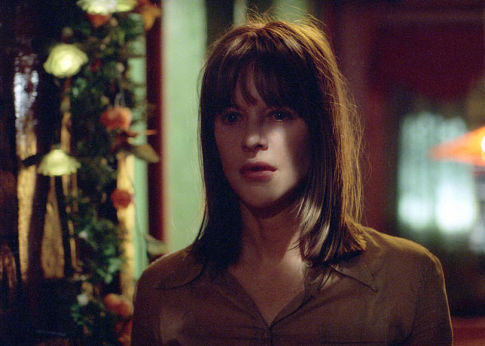IMDB
By Andrea Thompson
Seeing as how Valentine's Day is next week, I thought I'd devote this week's column to my more cynical side before I went all-out romantic for the holiday. So why not Jane Campion's 2003 film “In The Cut,” an erotic thriller that is also a kind of anti-love story? If that sounds hard to pin down, that's because it is, and critics seemed mostly unimpressed by it when it first came out. But “In the Cut” seems to be among a cadre of films directed by women in the early to mid-2000s, such as “Jennifer's Body” and “27 Dresses,” that are being rediscovered and reconsidered in light of our current times.
That said, “In the Cut” is also best appreciated as a product of its very specific time. As the film opens on a drab vision of NYC, the song Que Sera Sera plays, a seemingly cheerful number that's all about how unknowable our future is. It's certainly a concept that a city still reeling from the trauma and paranoia of 9/11 could relate to. Appropriately, the film's version of New York is steeped in shadow, and becomes increasingly as fractured as the unraveling mindset of its heroine Frannie Avery (Meg Ryan in a role originally written for Nicole Kidman, who is one of the film’s producers), a university professor.
IMDB
Frannie is the kind of complex, conflicted woman that's still all too rare on-screen, and Meg Ryan throws her all into this role with relish. Saying that she plays against the adorable type she became known for is putting it mildly. One of the first things she does is accidentally stumble across a faceless man getting a blow job from an equally faceless woman. Campion makes us feel as uncomfortable and voyeuristic as Frannie with a close up of the woman's mouth, with a clear view of the guy's member, making me realize I was probably watching the unrated director's cut.
Things only get more uncomfortable for Frannie from there. It's soon pretty clear that the men around her, a diverse set who vary in age and race, nevertheless share an entitled mindset, demanding that Frannie cater to their expectations, romantic or otherwise. A student walks out when she, his teacher, has the gall to criticize his writing. An ex (played by Kevin Bacon) is openly stalking her and shows up in her apartment unannounced and uninvited when she comes home, all while expecting her to give him the relationship he thinks she's obligated to. “Did the fact that we slept together twice mean nothing to you?” he demands in an angry voice message.
In such a misogynistic, painfully familiar environment, the gruesome murder investigation she becomes entangled with soon seems little more than an extreme version of everyday life, with the casually demeaning language the men around her use to describe the women in their lives, to the outright violence that includes a severed limb being found in Frannie's garden. This bloody discovery is how she meets Detective Malloy (Mark Ruffalo, in probably his sexiest on-screen role), who becomes interested in her after he stops by her apartment to ask if she knows anything about the murder that took place so close to home.
IMDB
Frannie is simultaneously fearful and fascinated by him as well, especially when she notices he has the same tattoo as the man she saw receiving oral in the bar, which she learns may have been the prelude to the murder. As the movie progresses, it's easy to see why many were turned off rather than on. Erotic thrillers are often a form of escapism, where the heat between two beautiful people, at least one of whom is typically very well-off, simmers until it explodes in a heat of passion. Women's sexuality becomes something of a sword and a shield, sometimes being used to manipulate a man, or explored by one who is suitably masculine, and thus swoonworthy. But “In the Cut” is more of a reflection of the real world, where women's sexuality is dangerous primarily because of how men react to it.
The story of her parents' courtship, and how it has affected her relationships, both with the men in her life and her half sister, is partly a reflection of this. Campion tells the story of how Frannie's parents met and fell in love through a giddily exaggerated, idealized romantic lens, only to bring it tumbling back to their grittier present by detailing its end, and how their father went on to fall hard again for someone else and marry about four times. This has led Frannie to become more reticent, while her sister Pauline (Jennifer Jason Leigh) embraces recklessness, what with her obsession with a married doctor and her residency above a strip club, which doubles as a skewed lens of how women are typically perceived. Pauline's eventual fate is one of the only facets of the film which is disappointingly predictable.
Another film would have Ruffalo's Malloy as the kind of exception, a dream boat amidst the crudity Frannie encounters. But there's a reason why Frannie is drawn to him even as she grows increasingly fearful of him. Ruffalo expertly plays Malloy as equal parts menacing and tender, often crude and only swoonworthy during the passionate, yet gentle love scenes. Meg Ryan may bare all, but it is Ruffalo who is more objectified, but not idealized, as he is able to bring Frannie pleasure in a way that allows her to experience a new kind of eroticism for her. As Frannie's world crumbles, Campion immerses us so well inside her unstable, grieving mental state we empathize with rather than condemn her increasingly idiotic decisions, which of course leads her straight into the killer's clutches.
When that killer finally is revealed, he doesn't so much give an explanation for his actions as the feelings which drive him. By that point, we don't need the reasons, and that's probably the real reason why so many people were uncomfortable with this film. What makes “In the Cut” so ultimately horrific is Campion's implicit suggestion that we don't need to look too far for the reasons why so many men feel entitled to kill women. We just need to look around us. At least there's cold comfort in the fact that Frannie is at least able to save herself and find her way back into Malloy's arms, who at last is able to give her a (temporary?) sense of safety.





